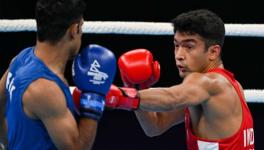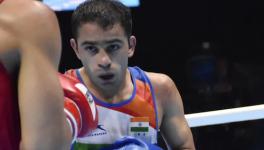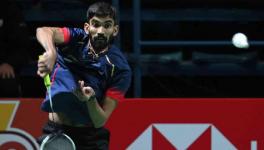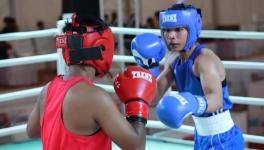Amit Panghal: Punching on a Prayer and Hope Cannot Make Up for Strategic Errors in Preparation
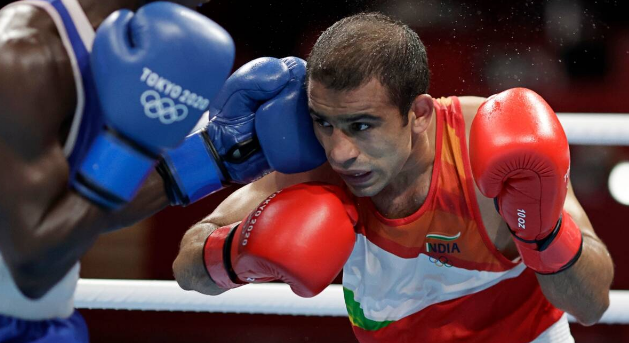
Yubjerjen Martinez of Colombia lands a left hook on Amit Panghal during their flyweight round of 16 bout at the Tokyo Olympics on Saturday (Pic: Indian Express, Twitter).
Amit Panghal got outclassed in the square at the Ryōgoku Kokugikan Olympic boxing arena in Tokyo. But, it seems, the seeds of this loss were sown a couple of months back at the Indian boxing team’s training base in Assisi, Italy.
India’s prize fighter — Panghal, the top seed and a World Championship silver medallist, and the country’s best bet at the Olympics in men’s boxing — was exposed to a would-be medal contender while in training. And when that medal contender — in an ironic twist — became Panghal’s opening opponent at the Games, it was time for the Indian team to try and salvage what they could. From expectations of an all conquering run, it suddenly became a salvage operation because Panghal was going into the bout with a mental handicap.
Click | For More Coverage of the Tokyo Olympics From Newsclick Sports
In the reported three bouts Panghal sparred with Colombia's Yuberjen Martinez in Italy during training, he struggled. The narrative was no different when the two clashed again in the round of 16 of the flyweight division at the Tokyo Olympics Saturday. The only difference was that the struggle turned up a few notches for Panghal — he was pounded, battered and routed. Like how they say, things get magnified at the Olympics.
Now, how can a world beater who is supposedly in prime form get battered so badly? We can understand a loss, but this type of debilitating and humiliating defeat? Panghal was running around the ring trying to evade and stay away from Martinez’s punches in the third round when the situation dictated he go in and score. It is a little hard to digest, and harder to accept. No, not the kind of unacceptance Mary Kom is pushing, ranting all over social media, but the kind that boxers and aficionados do, trying to affix some boxing logic on what happened in the ring. Some justification, some explanation!
Many factors played against Panghal, and most of those factors applied to all the boxers in the men’s contingent at the Games. The campaign for men is almost dead with just Satish Kumar still alive in his quarterfinals in the super heavyweight division. Till he is in the mix, an autopsy is premature, but after India’s biggest disappointment, and the underwhelming script that has been playing out in the opening rounds prior to this, taking the knives out is justified. So what actually went wrong?
“Fitness,” says Olympian and former international V Devarajan, who is also part of the national selection committee.
Also Read | Go For Gold. That’s All I Will Say to Her: Lovlina Borgohain’s First Coach
“It is evident that none of the Indian men were in the level of fitness required to be serious contenders at the Olympic level,” he adds. A former World Cup bronze medallist and one of India’s finest pugilists in the 1990s, Devarajan knows what he is talking about. “Panghal, Manish [Kaushik], Ashish Chaudhary and even the experienced Vikas [Krishan], everyone was below par. Now it beats my logic as to why this happened as they were all at a high level training camp and were getting set to give their best in Tokyo. But in the ring, they were all out of breath as the bout progressed. And not just out of breath, but it also affected their punches which lacked intent or impact.”
Vikas’ disappointment early on in the campaign was stunning in more ways than one. Yes, it happened in the opening round and against an unheralded fighter. Sewonrets Quincy Mensah Okazawa of Japan danced around Vikas and picked apart the third-time Olympian with ease. However Okazawa lost in the very next round to the Cuban in the mix — Roniel Iglesias, who is in the semifinals. It is clear that the Japanese boxer was no world beater but made to look like one against Vikas. Such was his dominance, or rather, the timidity Vikas displayed.
There was a reason and that again has its roots at the training camp. Post bout, it was revealed that Vikas was carrying a serious shoulder injury he had picked up a week or so before the Games. The Italian connection again.
Now, boxing is an injury-prone sport and sparring and training sessions often create niggles. It is clear Vikas’ was something larger than a niggle though. And, in the build-up to the Games, while training, the coaching staff should have been extra cautious about their boxers in sparring sessions. He, reportedly, got injured in the last sparring session before departure to Tokyo. That indeed is an unpardonable sin.
The exact science of fight preparation and even general logic dictate tapering. And tapering is not just to let the body recuperate from niggles and get the muscles and mind back in prime and fresh condition. Tapering also prevents injuries. It seems the training camp in Italy was not adhering to that maxim, or if they did, they were not very particular in implementing it effectively.
Also Read | Lovlina Borgohain’s Ring Craft Needs to Be Celebrated More than the Medal it Procured. Now We Push for More
In terms of implementation, we are forced to question the effectiveness of the camp itself when we see the other men struggle too, with only Satish showing glimpses of carrying enough fitness to last three rounds without huffing, puffing and running all over the ring. Having said that, Satish faces Bakhodir Jalolov of Uzbekistan in the quarterfinal and that bout could perhaps test the debutant Army boxer substantially more than his opening bout against Ricardo Brown of Jamaica.
The less-than-peak physical condition the rest were in could be because the Indian camp perhaps mistimed their conditioning programme. Maybe the focus was too much on ring-work, and in that mix, the other variables took a back seat. There could be many reasons for it and only an in depth inquest from the Boxing Federation of India will shed more light. Such an inquest will also reveal how the team managed to mess up the campaign of a champion boxer.
Panghal received a first-round bye thanks to his seeding. In hindsight, an outing prior to the round of 16 against a boxer of Martinez’s calibre could have helped him. But that’s just an assumption. The way the Colombian worked on Panghal, we are not sure whether anything could have helped.
The opening round went to the Indian, though, which raised quite a bit of hope in the camp. Indian boxing’s high performance director, Santiago Nieva, revealed to mediapersons after the bout that the points edge Panghal gained in the opening round boosted their confidence.
Also Read | Misfiring Guns and Booming Loose Cannons: The Burden of Being an Indian Shooter in Tokyo
“He [Martinez] did not have a great defence, it is just that he was landing some 100 punches in a minute. Amit could not keep pace with him, which was a first because he usually sets the pace,” said Nieva.
Panghal scored though, but as the coach mentioned, he was hardly dictating terms and there was a reason for that.
Panghal scored mostly from his left straights and hooks in the first round. Those were scoring blows but not exactly menacing ones. Those types of punches, ones with intent, came from the Colombian, who seemed oblivious to Panghal’s punches and were constantly working on the inside, to the body, and occasionally moving up with a hook or an uppercut.
The Colombian ignored Panghal’s punches not just because of his seasoned chin. The Indian was mostly punching on the fade, while swaying or moving backwards. Now that hardly gives him the leverage to execute powerful punches that could cast a doubt or two in the mind of Martinez. They were punches good for the reel, and for the judges, but not necessarily capable of inflicting a pugilistic message across to the opponent.
One boxing maxim, followed by boxers from Central and Latin America, is that attack is the best form of defence. While the Indian high performance director might feel the Colombian had no defence and based his strategic gamble on that fact, it never did matter to Martinez. Those “100” punches a minute shook Panghal up and he came out a different boxer in the second round. One who was unwilling to commit on the front foot. And he needed to attack.
Also Read | Olympian Lovlina Borgohain and Assam Boxing’s Sudden Revelation
The second and third round — till about 30 seconds left in the bout — went the same way with the Colombian punching, and Panghal ducking, weaving, running and taking some on the chin, ears and the body. Panghal, by then, was spent, and the last seconds of the bout, as if out of mercy to a training partner, or maybe to catch breath himself, Martinez eased off a wee bit.
“We knew what to expect but our hope was that Amit would stand up better in the last two rounds,” Nieva said. “He didn’t have the strength to move, so he stayed inside. Then [eventually] he didn’t have the strength to respond also and he became passive. There the Colombian scored a lot of points.”
Of course, fitness is the big question but then coach Nieva is also right when he points out that bouts against quality opponents would invariably take a toll no matter how much you condition your body. No conditioning prepares you for the actual rigour of a bout inside a ring when the stakes are high. That too when you are pounded left, right and centre.
Perhaps that is the reason why the Indian camp invited Martinez over for those fateful sparring sessions. It was perhaps to give Panghal quality opponents. Or perhaps to test him against a former Olympic medallist to see where he stands. Martinez had won a silver in Rio, in the light flyweight category which is not present in the Olympic programme anymore.
Whatever the logic was, the execution was poor. Because, when trainers or boxing coaches select sparring partners, they do it after they are sure that the fighter brought in will add value, and not take things away. It is evident that Martinez gained the most out of those sessions — both in confidence, and in fine-tuning the strategy he would need to put the Indian onto the ropes. And Panghal was right there too, almost on the ropes by the end of it all.
Also Read | Can Mirabai Chanu’s Olympic Silver Change the Manipur Athlete Storyline?
Imagine Muhammad Ali and Joe Frazier sparring a couple of months before they tried to kill each other in the ring. Now juxtapose the imagery this fictional scenario has created in your mind onto the Panghal vs Martinez dynamics. You will perhaps then get the absurdity in it.
Now the haze clears too. There is indeed a boxing logic in what transpired in the ring on Saturday. The fight followed the narrative that was planned by Martinez well in advance. And India just had “hope” as a strategy? That too after three minutes into the bout. It was hopeless from the start.
Get the latest reports & analysis with people's perspective on Protests, movements & deep analytical videos, discussions of the current affairs in your Telegram app. Subscribe to NewsClick's Telegram channel & get Real-Time updates on stories, as they get published on our website.










